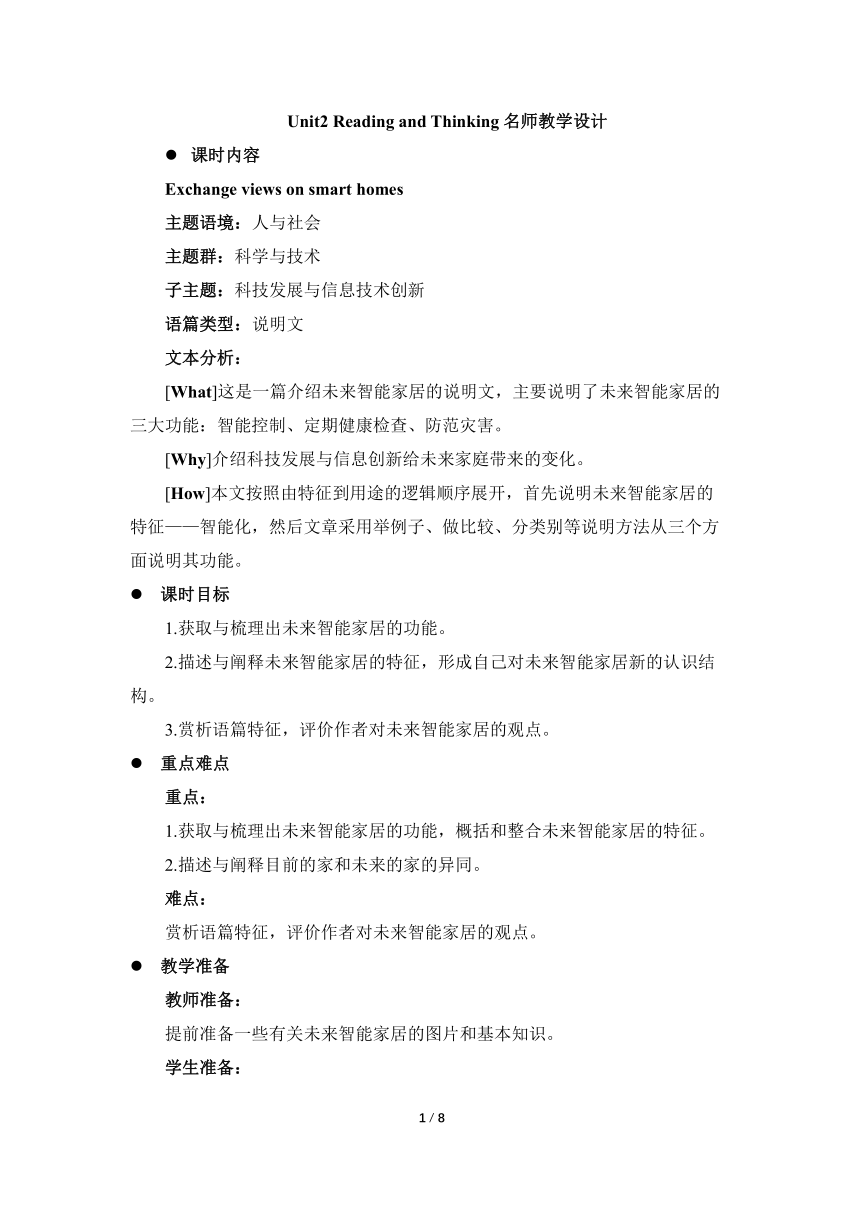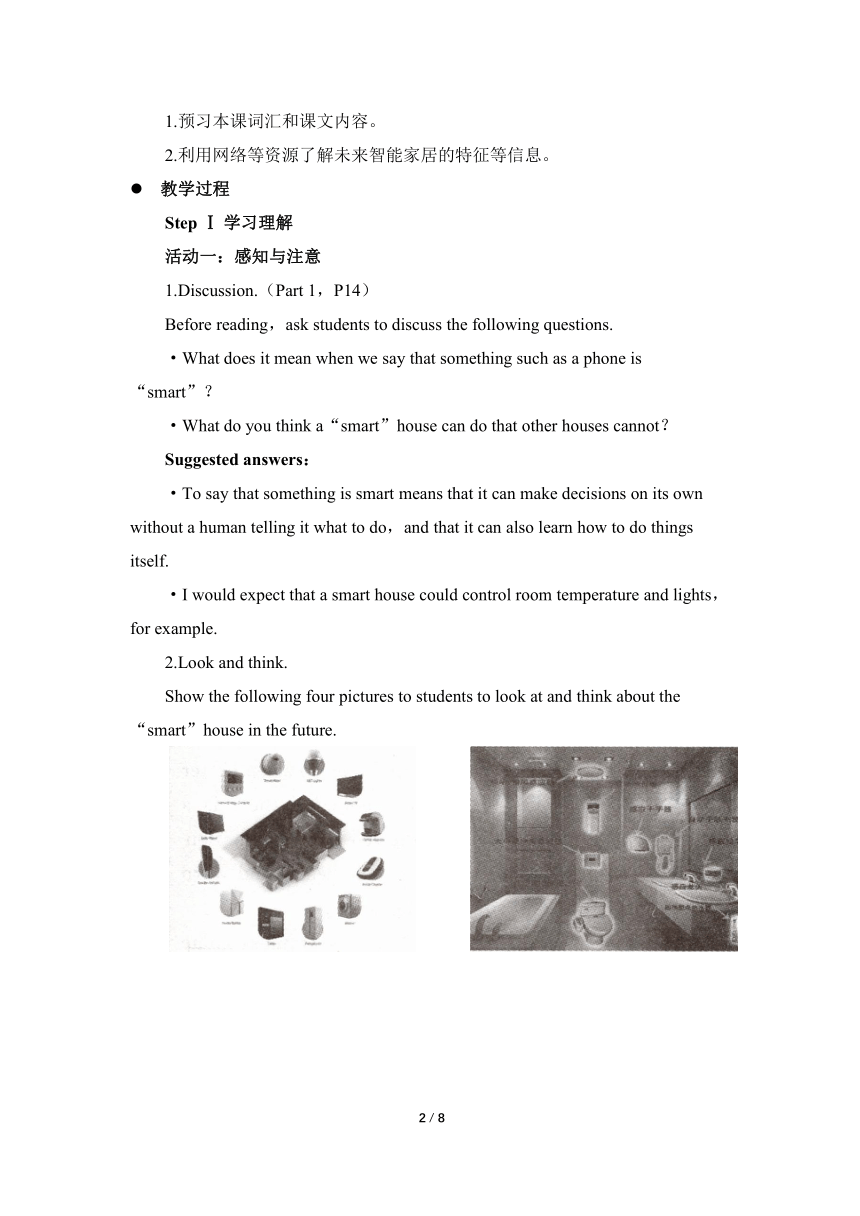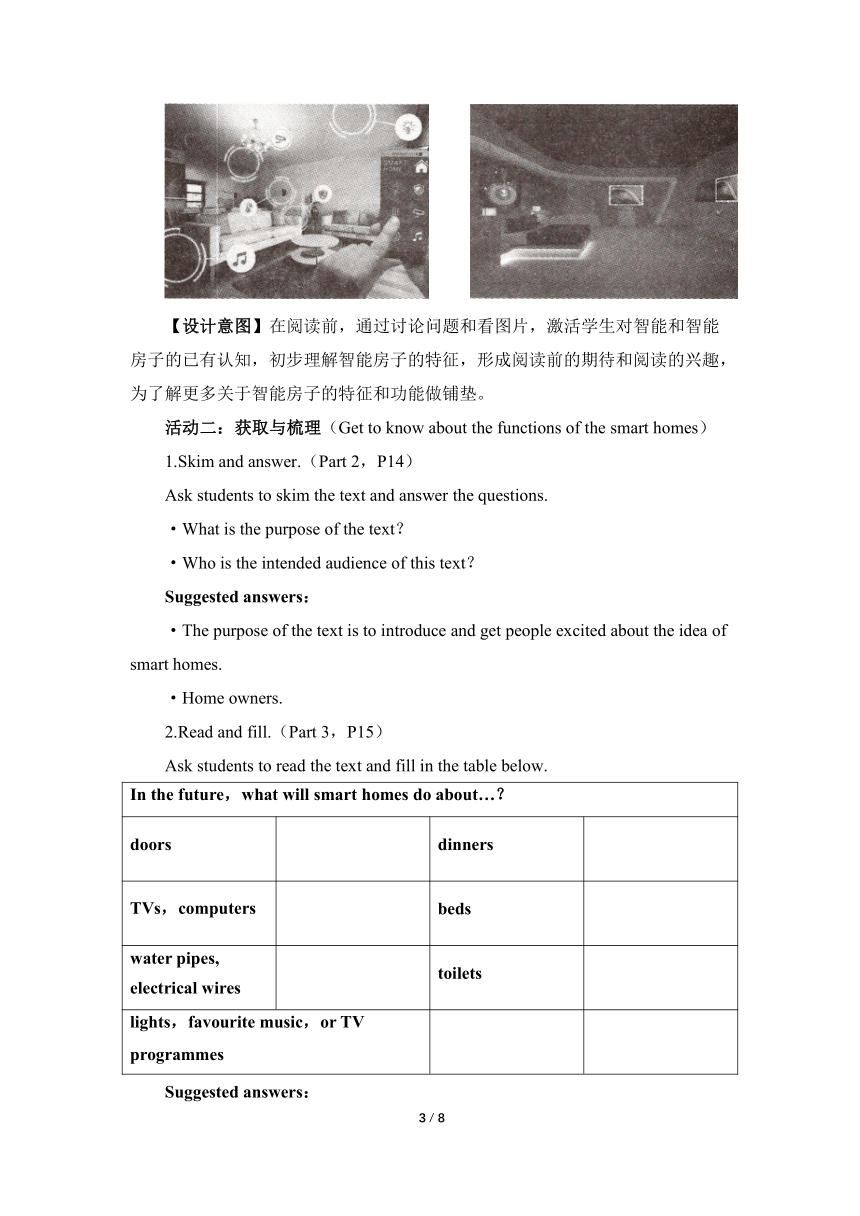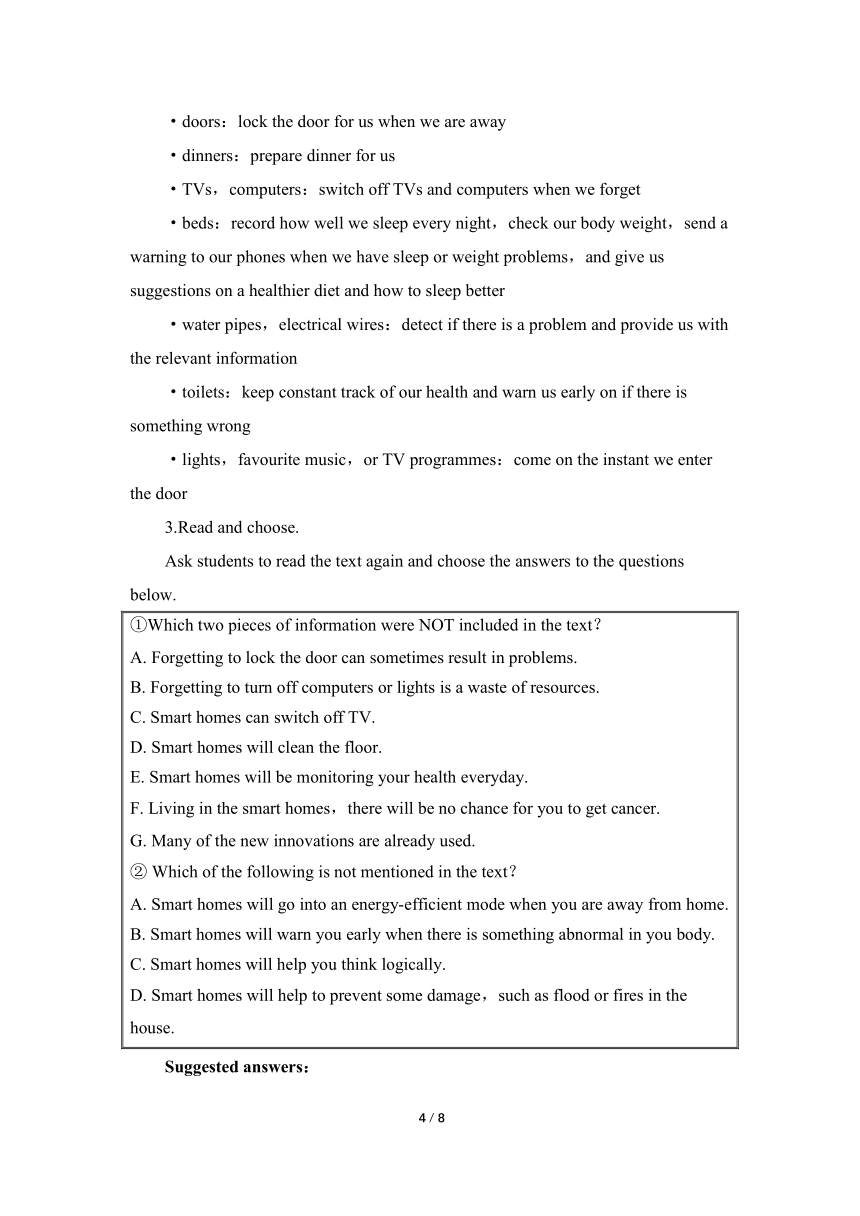人教版(2019)选择性必修 第一册Unit 2 Looking into the Future Reading and Thinking名师教学设计
文档属性
| 名称 | 人教版(2019)选择性必修 第一册Unit 2 Looking into the Future Reading and Thinking名师教学设计 |  | |
| 格式 | docx | ||
| 文件大小 | 1.7MB | ||
| 资源类型 | 教案 | ||
| 版本资源 | 人教版(2019) | ||
| 科目 | 英语 | ||
| 更新时间 | 2023-03-11 12:10:45 | ||
图片预览




文档简介
Unit2 Reading and Thinking 名师教学设计
课时内容
Exchange views on smart homes
主题语境:人与社会
主题群:科学与技术
子主题:科技发展与信息技术创新
语篇类型:说明文
文本分析:
[What]这是一篇介绍未来智能家居的说明文,主要说明了未来智能家居的三大功能:智能控制、定期健康检查、防范灾害。
[Why]介绍科技发展与信息创新给未来家庭带来的变化。
[How]本文按照由特征到用途的逻辑顺序展开,首先说明未来智能家居的特征——智能化,然后文章采用举例子、做比较、分类别等说明方法从三个方面说明其功能。
课时目标
1.获取与梳理出未来智能家居的功能。
2.描述与阐释未来智能家居的特征,形成自己对未来智能家居新的认识结构。
3.赏析语篇特征,评价作者对未来智能家居的观点。
重点难点
重点:
1.获取与梳理出未来智能家居的功能,概括和整合未来智能家居的特征。
2.描述与阐释目前的家和未来的家的异同。
难点:
赏析语篇特征,评价作者对未来智能家居的观点。
教学准备
教师准备:
提前准备一些有关未来智能家居的图片和基本知识。
学生准备:
1.预习本课词汇和课文内容。
2.利用网络等资源了解未来智能家居的特征等信息。
教学过程
Step Ⅰ 学习理解
活动一:感知与注意
1.Discussion.(Part 1,P14)
Before reading,ask students to discuss the following questions.
·What does it mean when we say that something such as a phone is“smart”?
·What do you think a“smart”house can do that other houses cannot?
Suggested answers:
·To say that something is smart means that it can make decisions on its own without a human telling it what to do,and that it can also learn how to do things itself.
·I would expect that a smart house could control room temperature and lights,for example.
2.Look and think.
Show the following four pictures to students to look at and think about the“smart”house in the future.
【设计意图】在阅读前,通过讨论问题和看图片,激活学生对智能和智能房子的已有认知,初步理解智能房子的特征,形成阅读前的期待和阅读的兴趣,为了解更多关于智能房子的特征和功能做铺垫。
活动二:获取与梳理(Get to know about the functions of the smart homes)
1.Skim and answer.(Part 2,P14)
Ask students to skim the text and answer the questions.
·What is the purpose of the text?
·Who is the intended audience of this text?
Suggested answers:
·The purpose of the text is to introduce and get people excited about the idea of smart homes.
·Home owners.
2.Read and fill.(Part 3,P15)
Ask students to read the text and fill in the table below.
In the future,what will smart homes do about…?
doors dinners
TVs,computers beds
water pipes, electrical wires toilets
lights,favourite music,or TV programmes
Suggested answers:
·doors:lock the door for us when we are away
·dinners:prepare dinner for us
·TVs,computers:switch off TVs and computers when we forget
·beds:record how well we sleep every night,check our body weight,send a warning to our phones when we have sleep or weight problems,and give us suggestions on a healthier diet and how to sleep better
·water pipes,electrical wires:detect if there is a problem and provide us with the relevant information
·toilets:keep constant track of our health and warn us early on if there is something wrong
·lights,favourite music,or TV programmes:come on the instant we enter the door
3.Read and choose.
Ask students to read the text again and choose the answers to the questions below.
①Which two pieces of information were NOT included in the text? A. Forgetting to lock the door can sometimes result in problems. B. Forgetting to turn off computers or lights is a waste of resources. C. Smart homes can switch off TV. D. Smart homes will clean the floor. E. Smart homes will be monitoring your health everyday. F. Living in the smart homes,there will be no chance for you to get cancer. G. Many of the new innovations are already used. ② Which of the following is not mentioned in the text? A. Smart homes will go into an energy-efficient mode when you are away from home. B. Smart homes will warn you early when there is something abnormal in you body. C. Smart homes will help you think logically. D. Smart homes will help to prevent some damage,such as flood or fires in the house.
Suggested answers:
①D,F ②C
【设计意图】学生使用扫读技巧进行阅读,了解文章的主要内容。通过阅读填写表格,理解智能的家的主要功能,获取相关细节信息,使得内容结构化、清晰化。使用跳读快速获取智能的家能够做的一些事。通过三个活动,使学生从不同侧面获取智能的家的功能,理解文本的主要意义。
Step Ⅱ 应用实践
活动三:描述与阐释(The characteristics of the smart homes)
Ask students to read the text again and try to describe the characteristics of the smart homes and give the reasons.
【设计意图】在学习理解类活动的基础上,通过使用所学语言描述未来智能的家的主要特征,并阐述其原因,该活动不仅可以发展学生的逻辑思维能力,而且可以提高语言表达能力。
活动四:内化与运用(Complete)
Ask students to complete the summary using the correct forms of the words from the text.
A smart home is one that i_______ computers into the structure of the building itself. In this way,many of the things that we now do ourselves will become a_______. For example,the smart home could control the air conditioning and lights so that you would no longer have to turn s_______ on and off,making your home more energy-e_______. The smart home could also m_______ itself to make sure that everything is working as it should,and send you w_______ if there is a problem. Such smart homes could even be programmed to d_______ your health problems,and then give you r_______ advice as to the food you should eat or if you should see a doctor. So,in a sense,smart homes will lead us to living smarter lives.
Suggested answers:
integrates;automatic;switches;efficient;monitor;
warnings;detect;relevant
【设计意图】学生在新的语境中,使用课文单词的适当形式完成一段介绍未来智能家居的概要,逐步实现对语言知识和文化知识的内化,巩固新的知识结构,促进语言运用的自动化,助力学生将知识转化为能力。
Step Ⅲ 迁移创新
活动五:赏析语篇的文体特征(Choice)
1.Ask students to circle the answers to the questions below.
① Where would you most likely find the text? A. In a book. B. In an advertisement. C. In a letter. D. In a newspaper. ② Which of the text methods is NOT employed? A. Illustration.(举例法) B. Classification.(分类法) C. Comparison.(比较法) D. Statistic.(列数字) ③What is the structure of the passage? ② A.① ③ ⑤ B.①→②→③→④→⑤ ④
Suggested answers:
①D ②D ③A
2.Ask students to discuss the questions and share the answers.
·Which part of the text impresses you most?
Why?
·Which paragraph or sentence do you like most? Give your reasons.
【设计意图】在完成选择题的基础上,了解说明文的语篇结构和文本特征。该活动不仅能够帮助学生提高对英语说明文的理解和欣赏能力,还有助于提高学生的写作能力。
活动六:评价作者的观点(Critical thinking)
Ask students to work in groups and discuss the following questions and then share the answers.
·In what way is the home of tomorrow already the home of today?
·What might be some of the disadvantages of smart homes?
·The author thinks that smart homes can make life easier. Do you agree with the author’s viewpoint?
Why or why not ?
Suggested answers:
·Many of the new innovations are already used in some homes today. This is true especially of automatic controls for things such as lights and air conditioners.
·One disadvantage is that if there is a problem with the system,you may find yourself locked out of the house,or unable to turn your TV off or on. Security is another big concern,as strangers may be able to hack into the system to collect information about your life and use that for evil purposes.
·(略)
【设计意图】该活动要求学生能够分析概括在说明某一道理时作者的看法,而不是单纯分析所述事件或说明道理本身的具体内容。在评价作者观点的同时,学生能够理性表达自己的观点和态度,实现深度学习,促进能力向素养的转化。
板书设计
Unit 2 Looking into the Future Period Ⅰ Reading and Thinking Ⅰ.学习理解 活动一:感知与注意 1.Discussion. 2.Look and think. 活动二:获取与梳理(Get to know about the functions of the smart homes) 1.Skim and answer. 2.Read and fill. 3.Read and choose. Ⅱ.应用实践 活动三:描述与阐释(The characteristics of the smart homes) 活动四:内化与运用(Complete) Ⅲ.迁移创新 活动五:赏析语篇的文体特征(Choice) 活动六:评价作者的观点(Critical thinking)
2 / 2
课时内容
Exchange views on smart homes
主题语境:人与社会
主题群:科学与技术
子主题:科技发展与信息技术创新
语篇类型:说明文
文本分析:
[What]这是一篇介绍未来智能家居的说明文,主要说明了未来智能家居的三大功能:智能控制、定期健康检查、防范灾害。
[Why]介绍科技发展与信息创新给未来家庭带来的变化。
[How]本文按照由特征到用途的逻辑顺序展开,首先说明未来智能家居的特征——智能化,然后文章采用举例子、做比较、分类别等说明方法从三个方面说明其功能。
课时目标
1.获取与梳理出未来智能家居的功能。
2.描述与阐释未来智能家居的特征,形成自己对未来智能家居新的认识结构。
3.赏析语篇特征,评价作者对未来智能家居的观点。
重点难点
重点:
1.获取与梳理出未来智能家居的功能,概括和整合未来智能家居的特征。
2.描述与阐释目前的家和未来的家的异同。
难点:
赏析语篇特征,评价作者对未来智能家居的观点。
教学准备
教师准备:
提前准备一些有关未来智能家居的图片和基本知识。
学生准备:
1.预习本课词汇和课文内容。
2.利用网络等资源了解未来智能家居的特征等信息。
教学过程
Step Ⅰ 学习理解
活动一:感知与注意
1.Discussion.(Part 1,P14)
Before reading,ask students to discuss the following questions.
·What does it mean when we say that something such as a phone is“smart”?
·What do you think a“smart”house can do that other houses cannot?
Suggested answers:
·To say that something is smart means that it can make decisions on its own without a human telling it what to do,and that it can also learn how to do things itself.
·I would expect that a smart house could control room temperature and lights,for example.
2.Look and think.
Show the following four pictures to students to look at and think about the“smart”house in the future.
【设计意图】在阅读前,通过讨论问题和看图片,激活学生对智能和智能房子的已有认知,初步理解智能房子的特征,形成阅读前的期待和阅读的兴趣,为了解更多关于智能房子的特征和功能做铺垫。
活动二:获取与梳理(Get to know about the functions of the smart homes)
1.Skim and answer.(Part 2,P14)
Ask students to skim the text and answer the questions.
·What is the purpose of the text?
·Who is the intended audience of this text?
Suggested answers:
·The purpose of the text is to introduce and get people excited about the idea of smart homes.
·Home owners.
2.Read and fill.(Part 3,P15)
Ask students to read the text and fill in the table below.
In the future,what will smart homes do about…?
doors dinners
TVs,computers beds
water pipes, electrical wires toilets
lights,favourite music,or TV programmes
Suggested answers:
·doors:lock the door for us when we are away
·dinners:prepare dinner for us
·TVs,computers:switch off TVs and computers when we forget
·beds:record how well we sleep every night,check our body weight,send a warning to our phones when we have sleep or weight problems,and give us suggestions on a healthier diet and how to sleep better
·water pipes,electrical wires:detect if there is a problem and provide us with the relevant information
·toilets:keep constant track of our health and warn us early on if there is something wrong
·lights,favourite music,or TV programmes:come on the instant we enter the door
3.Read and choose.
Ask students to read the text again and choose the answers to the questions below.
①Which two pieces of information were NOT included in the text? A. Forgetting to lock the door can sometimes result in problems. B. Forgetting to turn off computers or lights is a waste of resources. C. Smart homes can switch off TV. D. Smart homes will clean the floor. E. Smart homes will be monitoring your health everyday. F. Living in the smart homes,there will be no chance for you to get cancer. G. Many of the new innovations are already used. ② Which of the following is not mentioned in the text? A. Smart homes will go into an energy-efficient mode when you are away from home. B. Smart homes will warn you early when there is something abnormal in you body. C. Smart homes will help you think logically. D. Smart homes will help to prevent some damage,such as flood or fires in the house.
Suggested answers:
①D,F ②C
【设计意图】学生使用扫读技巧进行阅读,了解文章的主要内容。通过阅读填写表格,理解智能的家的主要功能,获取相关细节信息,使得内容结构化、清晰化。使用跳读快速获取智能的家能够做的一些事。通过三个活动,使学生从不同侧面获取智能的家的功能,理解文本的主要意义。
Step Ⅱ 应用实践
活动三:描述与阐释(The characteristics of the smart homes)
Ask students to read the text again and try to describe the characteristics of the smart homes and give the reasons.
【设计意图】在学习理解类活动的基础上,通过使用所学语言描述未来智能的家的主要特征,并阐述其原因,该活动不仅可以发展学生的逻辑思维能力,而且可以提高语言表达能力。
活动四:内化与运用(Complete)
Ask students to complete the summary using the correct forms of the words from the text.
A smart home is one that i_______ computers into the structure of the building itself. In this way,many of the things that we now do ourselves will become a_______. For example,the smart home could control the air conditioning and lights so that you would no longer have to turn s_______ on and off,making your home more energy-e_______. The smart home could also m_______ itself to make sure that everything is working as it should,and send you w_______ if there is a problem. Such smart homes could even be programmed to d_______ your health problems,and then give you r_______ advice as to the food you should eat or if you should see a doctor. So,in a sense,smart homes will lead us to living smarter lives.
Suggested answers:
integrates;automatic;switches;efficient;monitor;
warnings;detect;relevant
【设计意图】学生在新的语境中,使用课文单词的适当形式完成一段介绍未来智能家居的概要,逐步实现对语言知识和文化知识的内化,巩固新的知识结构,促进语言运用的自动化,助力学生将知识转化为能力。
Step Ⅲ 迁移创新
活动五:赏析语篇的文体特征(Choice)
1.Ask students to circle the answers to the questions below.
① Where would you most likely find the text? A. In a book. B. In an advertisement. C. In a letter. D. In a newspaper. ② Which of the text methods is NOT employed? A. Illustration.(举例法) B. Classification.(分类法) C. Comparison.(比较法) D. Statistic.(列数字) ③What is the structure of the passage? ② A.① ③ ⑤ B.①→②→③→④→⑤ ④
Suggested answers:
①D ②D ③A
2.Ask students to discuss the questions and share the answers.
·Which part of the text impresses you most?
Why?
·Which paragraph or sentence do you like most? Give your reasons.
【设计意图】在完成选择题的基础上,了解说明文的语篇结构和文本特征。该活动不仅能够帮助学生提高对英语说明文的理解和欣赏能力,还有助于提高学生的写作能力。
活动六:评价作者的观点(Critical thinking)
Ask students to work in groups and discuss the following questions and then share the answers.
·In what way is the home of tomorrow already the home of today?
·What might be some of the disadvantages of smart homes?
·The author thinks that smart homes can make life easier. Do you agree with the author’s viewpoint?
Why or why not ?
Suggested answers:
·Many of the new innovations are already used in some homes today. This is true especially of automatic controls for things such as lights and air conditioners.
·One disadvantage is that if there is a problem with the system,you may find yourself locked out of the house,or unable to turn your TV off or on. Security is another big concern,as strangers may be able to hack into the system to collect information about your life and use that for evil purposes.
·(略)
【设计意图】该活动要求学生能够分析概括在说明某一道理时作者的看法,而不是单纯分析所述事件或说明道理本身的具体内容。在评价作者观点的同时,学生能够理性表达自己的观点和态度,实现深度学习,促进能力向素养的转化。
板书设计
Unit 2 Looking into the Future Period Ⅰ Reading and Thinking Ⅰ.学习理解 活动一:感知与注意 1.Discussion. 2.Look and think. 活动二:获取与梳理(Get to know about the functions of the smart homes) 1.Skim and answer. 2.Read and fill. 3.Read and choose. Ⅱ.应用实践 活动三:描述与阐释(The characteristics of the smart homes) 活动四:内化与运用(Complete) Ⅲ.迁移创新 活动五:赏析语篇的文体特征(Choice) 活动六:评价作者的观点(Critical thinking)
2 / 2
